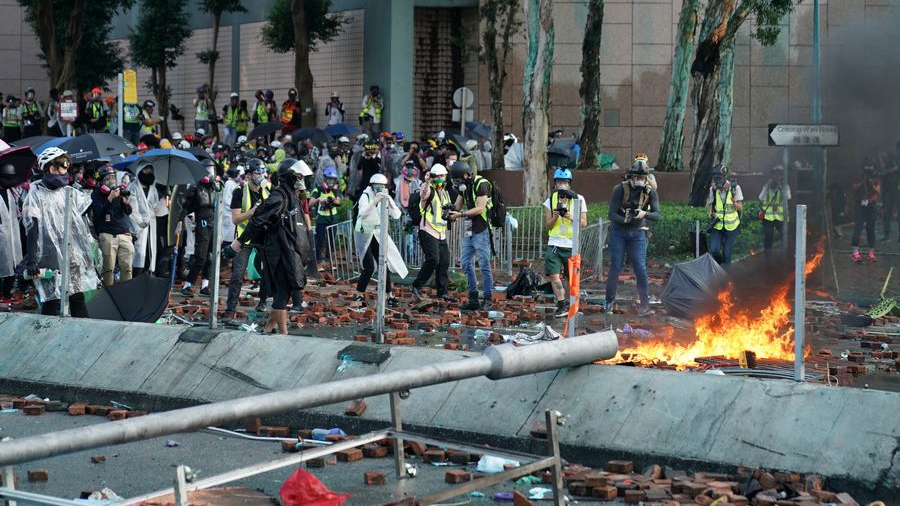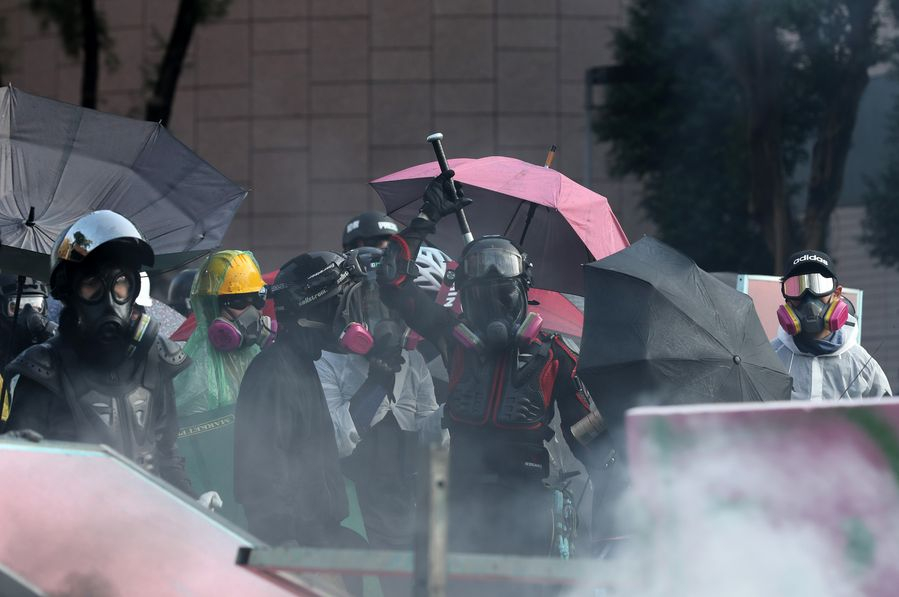
Rioters in standoff with police outside of Hong Kong Polytechnic University in Hong Kong, south China, , November 17, 2019. /Xinhua Photo
Rioters in standoff with police outside of Hong Kong Polytechnic University in Hong Kong, south China, , November 17, 2019. /Xinhua Photo
Editor's note: James Rae is a professor from California State University Sacramento. He was also a Fulbright Scholar at Beijing Foreign Studies University from 2017 to 2018. The article reflects the author's opinions, and not necessarily the views of CGTN.
Hong Kong is facing a crisis over law and order. Some have claimed this to be a humanitarian crisis. It is not.
Activists took over the campus of Hong Kong Polytechnic University for the past week and pushed their confrontation with Hong Kong police to the breaking point on the night of November 17.
Few if any of the activists appear to be students or in any way affiliated with the university, yet found it a convenient staging ground for their confrontation with the police.
These masked protesters stole chemicals from at least three universities, including PolyU, while concocting petrol bombs to throw at police and even using catapults to extend the range, while throwing bricks, setting fires, and destroying public property.
Indeed, one officer was shot with an arrow and other officers in another location were nearly rammed by a vehicle, even ordinary citizens have become targets.
Police deemed the situation a riot, secured the perimeter of the campus and demanded a surrender from those committing violent acts. Police sprayed water to deter the protesters, and used tear gas to little effect since near all of the activists wear gas masks. Many protesters slipped away in the night, while others hunkered down to continue the conflict.
Relief and medical care were provided to the students, who have an offer of a lesser charge if they cease their campus holdout. Media access by licensed journalists has been unfettered and images and videos of the scene are uncensored.
This is no humanitarian crisis, and the short-term crisis that exists is fueled by these unknown and seemingly leaderless activists, intent on occupying this campus to bait police into a heavy-handed crackdown on live television with the perverse hope that it may elicit some type of foreign intervention.

A rioter draws out his weapon in standoff with police outside of Hong Kong Polytechnic University in Hong Kong, south China, , November 17, 2019. /Xinhua Photo
A rioter draws out his weapon in standoff with police outside of Hong Kong Polytechnic University in Hong Kong, south China, , November 17, 2019. /Xinhua Photo
Some of the protesters even asked America and Britain to save them while holding British and American flags.
This latest spark in the ongoing fire is worrisome as these are not the mass popular protests that were evident earlier in the summer that were a direct response to the Fugitive Bill.
These actions are by a small group of masked activists who have violated the law by occupying a campus and stealing chemicals from laboratories and violently attacked the police.
From June until now, Hong Kong remains as it was formally. The Fugitive Bill has been withdrawn. Media operates independently and provides competing points of view on the current situation. The rule of law has been maintained, indeed a Hong Kong court overruled the ban on masks, striking a blow against the government.
The Hong Kong police have upheld professional standards of conduct by and large over the course of the six months of turmoil, and have followed protocol and the law in their engagement with demonstrators.
Finally, Beijing has been impressively restrained in allowing the local authorities to maintain autonomy over the process and tolerating dramatic challenges to the safety and security of the Special Administrative Region.
The endgame is still the same. Hong Kong is part of China, protesters calling for independence have a hopeless and naive perspective. The "One Country, Two Systems" model has stood the test of time for over two decades, making Hong Kong a model city for pluralism, good governance, multiculturalism, stability, and innovation.
These violent protesters undermine broader sympathies for reforming or simply maintaining the current governing structures in Hong Kong. The current model has an expiration date, and those who hope to maintain the existing formula may be damaged by the current lawlessness.
These violent tactics by masked protesters with no constructive stake in Hong Kong's future will win virtually no support within or without China. Exaggerating claims of a humanitarian crisis on social media does a disservice to the real jeopardy many in the world face from man-made or natural disasters and should not become a term of mere convenience for political utility.
(If you want to contribute and have specific expertise, please contact us at opinions@cgtn.com.)